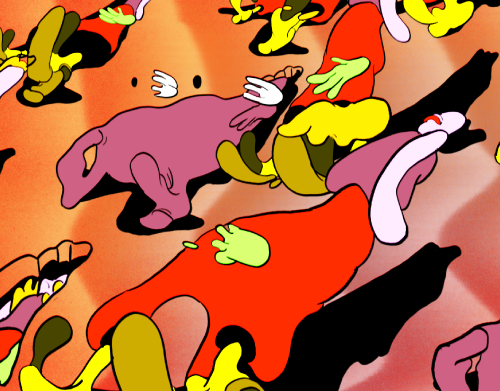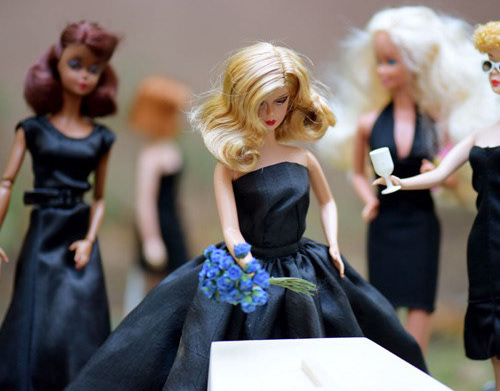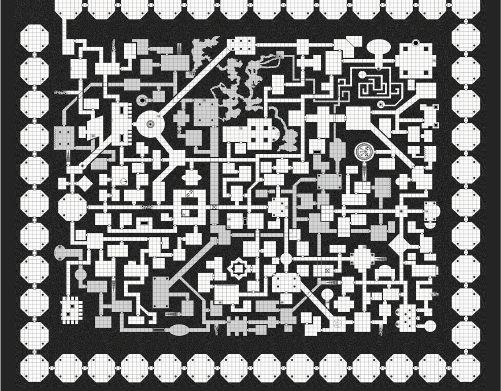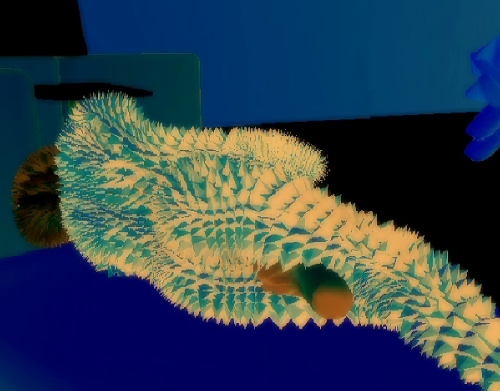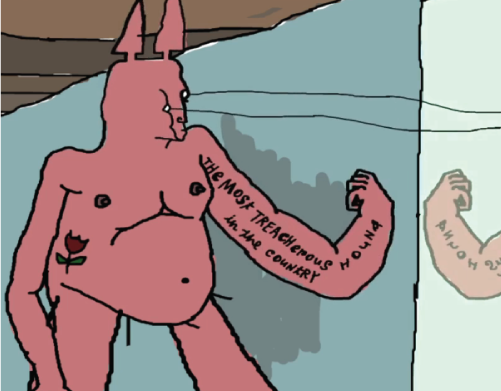Playing Human VS Playing the Sims
An Essay by Sophie Koko Gate
From MM04, released November 2019
An Essay by Sophie Koko Gate
From MM04, released November 2019
----
Hi ;)
My favorite fantasy to think about is the one where I’m pretending to be human.
I’m not from here you see, these are not my customs. To blend in l simulate small talk, and mirror your own personality which you will enjoy! I bend over sideways, how about this: I laugh as loud as you can scream. I angle my eyebrows to mourn your DEAD DOG. I cut a fringe.. Yes. I have studied humans — with your cars and salads. And for the most part, I am convincing. Like the Coneheads, but with less Cone.
Then the next best thing is to imagine that I am the only ‘human’ on the planet — and everyone else is faking it. I can see the cracks — when you laugh at the wrong time, when you eat waaay too fast. I like it when you malfunction, it’s cute! It’s inspiring. I fall in love with your malfunctions because it reminds me of your alien beginnings.
I think I find these imaginary states comforting because I was born in 1989 which meant that by the year 2000, the year that The Sims came out, I was 11 years old. The ideal age for obsessive, all-consuming, life-destroying PC video game playing. A comfort blanket of a world that you had complete control over, Sims pretending to be humans. I especially liked how there were pauses between their interactions with each other. As if they had been given a long time to think up the best answer possible to a question, but still they manage to fuck it up by speaking Simglish. This is something that has directly influenced the dialogue in my animations.
Anyway, back to The Sims. My friends and I had finally found a game that understood us. We could replicate reality and skew it into one that suited us. The perfect escapism for our drab teenage existence. Rosebud. Klapaucius. We were all obsessed. If you read my diary from the year 2000–2004 it will tell you exactly what my Sims did that day. And of course, a bad day at school (I am ginger) meant a bad day for my Sims. Take away the windows and doors, place a BBQ on the carpet. Make a chocolate milk and wait for the Grim Reaper to come and wave his scythe through the fire. I killed my Physics teacher when I was 12, after bearing his child and making it ginger. The most long-lasting evil I could think of at that time.
Fast forward 15 years and all this has not gone un-noticed. I’ve found a similar form of escapism, one that I can control without cheats and extension packs. I’m at the Royal College of Art studying Animation. At first rejected but after sending a few videos of me crying into a webcam (and some poetry) they finally succumb.
Still from “Don’t You Want Me Baby” 2011, by Sophie Koko Gate
At the RCA you are often asked the question: why? The reason I think a lot of Royal College of Art films are so inherently serious and drab is down to the simple fact that you are challenged during every step of the film making process. (the beginning of Half Wet was intended as a parody to these isolated sad male characters that litter the RCA archives). Imagine having to justify every decision you make, it’s enough to make anyone have an existential crisis. Nonetheless, it is a good question to start with. Why the fuck do you want to make an animated film you narcissistic, nihilistic, sadistic piece of shit.
Before I started making films, I needed to have a very clear answer to this, as well as the type of filmmaker I wanted to be — is there anything new that I could bring to the table? The table was male dominated and intimidating. In my Graphic Design course my approach to feminism was aggressive and crude — the opposite of what I thought a woman should be like, which in itself is not very feminist is it.
Some examples of aggressive feminism:
Untitled, 2011, by Sophie Koko Gate
A Vagina Tent, 2011
A Projected Vagina, 2010
Something that I hadn’t found yet in animated shorts, was a feeling of control, comfort and maybe pleasure is the word I’m looking for. Basically, the feelings I got from playing the Sims.
After searching ‘female animators’ into google and finding the films of Sally Cruikshank, Amy Lockhart, Susan Pitt, (none of which were taught in class) I started to feel more confident to create with an unashamed feminine voice. This is interesting to me because it might explain why there is such an unbalance for female show creators and directors — simply because there aren’t enough visible role models, and even when there are — you need to be introduced to them in order to know about them. This comes right down to diversity in the artists that teachers talk about — there should be a quota for this as well as the teachers themselves imho.
There is the temptation for me sometimes to make gross, disturbing, or sexual work to distance myself from being classically femme. — something that I still see as being a slightly weak or negative thing, even though I am femme AF. It might also be why the style of my work is classified as ‘Ugly’ or has developed in an off-kilter way. My switch to airbrush shading was a way to rectify this — with prettier shading you can seduce more people in to watch your shit films. This was largely inspired by the work of Ron Nagle and Hans Coper — ceramics has always been in the background of my upbringing and largely ignored. After seeking a prettier style, it felt natural to turn to the things I find the most ‘pretty’ — sold round smooth glossy shapes. Big ol slabs of clay, grounded and thicc. With a lot of trial error, I developed the airbrush style that mimicked these feelings in Photoshop. (Why didn’t I just use clay?)
Self-portrait with Hans Coper pot, 2015, by Sophie Koko Gate
Ron Nagle, Handlin Bambi, 2015
It has now evolved into more of a personal challenge for me to keep the style of my work on the slightly unappealing side, whilst still gaining attention. This is helped by inspiring artists who succeeded in make ugly work by appealing to people’s bad tastes. (see Mika Rottenberg, Philip Guston)
For me, it is hard not to think you must mimic a masculine take on things because that seems to be what gets seen and heard the loudest. The lead character in Half Wet is male because I assumed that’s what people wanted to see. A male protagonist! Because of internalised misogyny! How gross is that!
Before embarking on my first film — I felt the need to softly rebel against classic plot structure. I knew I wanted to recreate that feeling I got when playing the Sims, when existing in my fantasy of fake humans.
I realised that a lot of the films I watched had stakes, the bigger the stakes, the better the story, apparently. The journey of the character is essential, what does HE become, what does HE want? How does HE overcome his bad personality traits?
Philip Guston, The Line, 1978
Mika Rottenberg, NoNoseKNows, 2015
I liked watching these indie films to get a sense of exactly what I wanted to avoid in my own film making.
Another thing I noticed, having jumped from only knowing Ren & Stimpy to going to the Royal College of Art: there seemed to be a huge gap between indie animation, and cartoons, with 2 very different audiences.. I am trying to fit somewhere in between the two.
I do this by creating colourful, digital and often ‘trendy’ cartoon characters that exist inside an indie film. The indie film is not designed to make you laugh or cry but instead to keep you company. There is little plot line to engage with, which was an attempt to isolate the characters themselves, their personalities unveiling through regular activity. The characters are strange, they are like you on a bad day. They look directly at you and question your engagement.
Admittedly It’s a grossly self-indulgent world that they live in. Everything that I want them to do, they do! The zoom in and microscopic worlds are inspired by seizures I would get as a kid. Luckily I was kind of into them, they felt almost euphoric — I would become really huge and everything around me turned miniature! I am allergic to a sweetener called Aspartame.
It seemed also strange to me that characters are born and exist briefly on a screen, and then are buried. I wanted to know what would happen if the characters lived on and grew older, wiser, maybe more depressed. (A bit like the Sims lol). Their personalities are human: complex and layered. A typical audience watching a film will without knowing, subconsciously try to label and categorize popular character traits and try to guess what comes next in the storyline. They do this using their unknown but deep-set prior knowledge of plot device and strategy from years of film watching. I was interested in playing with the assumptions of the audience and exploring narrative and dialogue in a non-traditional but still, linear, form.
Basically, like the Sims. God I’m annoying! Sorry. It’s an essay. My worries are that, like this essay, and also like the Sims, the films themselves have the risk of being inward facing — as their origins are simply an essence of a feeling that I’m trying to re-create. Do I spend months of my life making work so that I can escape into it and not have to talk to the aliens that are surrounding me? ………… BYE
----
----
If you enjoyed this interview, please consider purchasing a physical copy.
Your support keeps the magazine running, thank you.
Your support keeps the magazine running, thank you.
© Mostly Moving 2020

